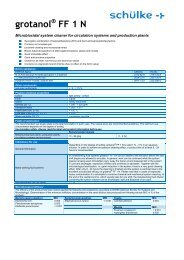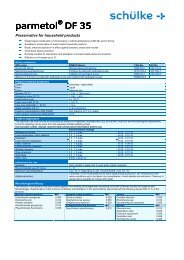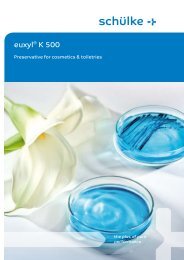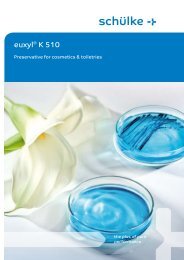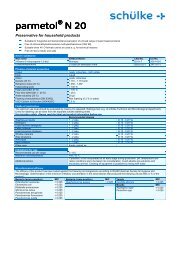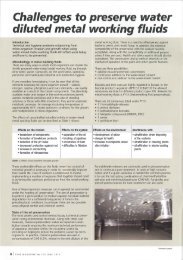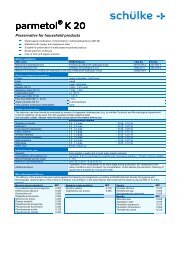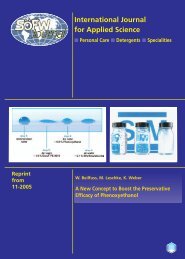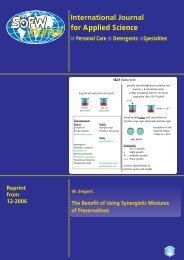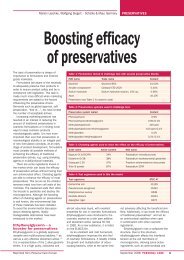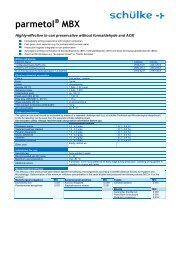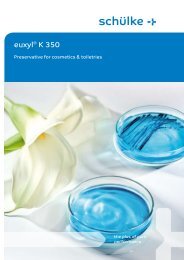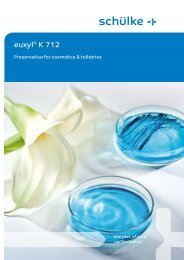ISO 11930 â A Comparison to other Methods to ... - ResearchGate
ISO 11930 â A Comparison to other Methods to ... - ResearchGate
ISO 11930 â A Comparison to other Methods to ... - ResearchGate
Create successful ePaper yourself
Turn your PDF publications into a flip-book with our unique Google optimized e-Paper software.
COSMETICS<br />
PRESERVATION<br />
tion of drugs under the strong requirements<br />
of the pharmaceutical GMP (Good<br />
Manufacturing Practice). Additionally the<br />
Table 14 Test results lotion preservative 1<br />
useable lifespan after opening of cosmetic<br />
products are generally longer than<br />
for pharmaceutical products.<br />
The schülke KoKo test is specifically verified<br />
for the assessment of cosmetic<br />
products. From more than 25 years of experience<br />
(11, 12) with this test method,<br />
we can state a 30 month microbiological<br />
stability for a product passing criteria<br />
A, which is recommended for cosmetic<br />
products.<br />
The lotion with the preservative system<br />
1 passed only <strong>ISO</strong> <strong>11930</strong> and Ph. Eur. criteria<br />
B. Nevertheless, even 28 days after<br />
the inoculation with Aspergillus brasiliensis<br />
it was still detectable. Within 7 days<br />
the decrease of moulds is insufficient,<br />
the KoKo failed.<br />
The lotion with the preservative system<br />
2 and 3 passed <strong>ISO</strong> <strong>11930</strong> and Ph. Eur.;<br />
KoKo showed only slight growth in the<br />
last cycles, it fulfils criteria B.<br />
Table 15 Test results lotion preservative 2<br />
Table 16 Test results lotion preservative 3<br />
Precision and reproducibility of<br />
preservative efficacy tests<br />
To assess the differences of the results in<br />
the various test methods, it is important<br />
<strong>to</strong> realise the variation in microbiological<br />
test results. The GÖCH has published<br />
the results of a round robin test for Ph.<br />
Eur. - 5.1.3 »Efficacy of Antimicrobial<br />
Preservation« (10). The microbial counts<br />
differed widely between the labora<strong>to</strong>ries.<br />
Fig. 2 shows an overview of the results<br />
including expanded uncertainty.<br />
For the <strong>other</strong> methods this data is not<br />
available, probably however it can be assumed<br />
that it will be in the same range.<br />
Borderline results with low reduction in<br />
microbial counts might fail in a replicate.<br />
Uncertain contaminations during production<br />
combined with an insufficient<br />
speed of killing may lead <strong>to</strong> detection of<br />
contamination in the market place. The<br />
worst case is the inclusion in the RAPEX<br />
notifications (13).<br />
■ Conclusion<br />
Table 17 Test results lotion preservative 4<br />
The <strong>ISO</strong> <strong>11930</strong> as new standard <strong>to</strong> evaluate<br />
the antimicrobial protection of a<br />
cosmetic product includes reference<br />
method <strong>to</strong> evaluate the preservation, as<br />
well as a decision diagram <strong>to</strong> evaluate<br />
the microbiological risk. The recommended<br />
preservation efficacy test is less strict<br />
than the Ph. Eur. and the KoKo test (see<br />
Experimental data). The microbial strains<br />
SOFW-Journal | 138 | 7-2012 51




